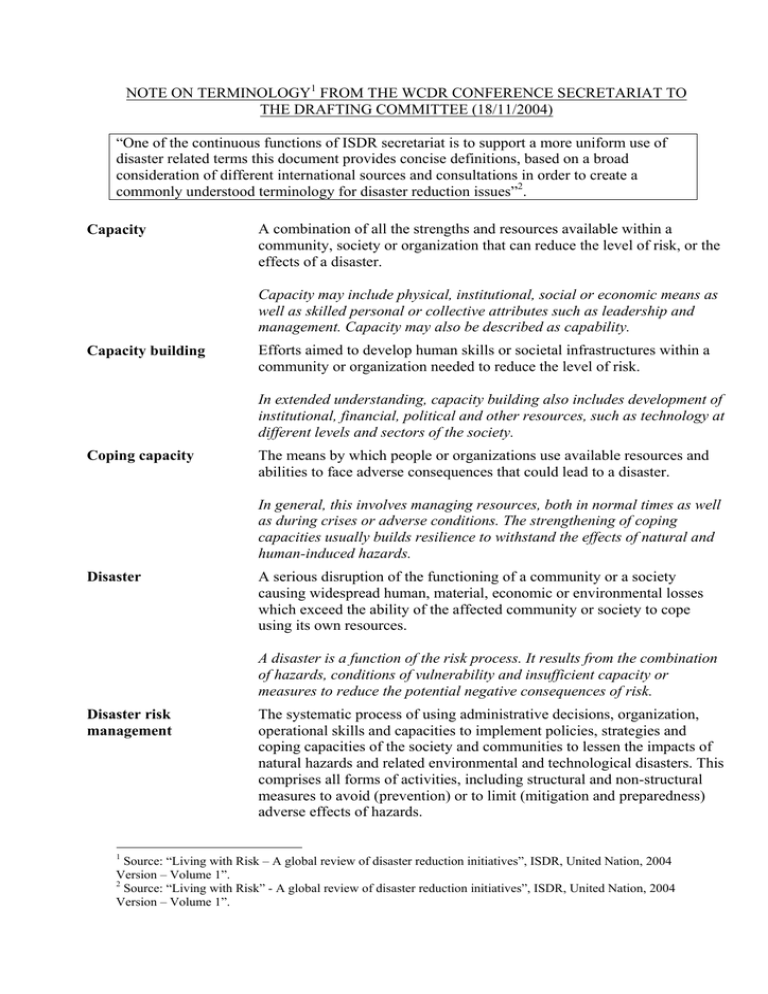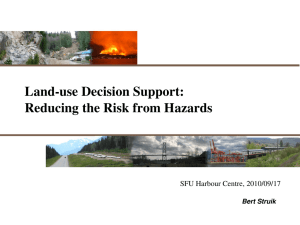NOTE ON TERMINOLOGY1 FROM THE WCDR
advertisement

NOTE ON TERMINOLOGY1 FROM THE WCDR CONFERENCE SECRETARIAT TO THE DRAFTING COMMITTEE (18/11/2004) “One of the continuous functions of ISDR secretariat is to support a more uniform use of disaster related terms this document provides concise definitions, based on a broad consideration of different international sources and consultations in order to create a commonly understood terminology for disaster reduction issues”2. Capacity A combination of all the strengths and resources available within a community, society or organization that can reduce the level of risk, or the effects of a disaster. Capacity may include physical, institutional, social or economic means as well as skilled personal or collective attributes such as leadership and management. Capacity may also be described as capability. Capacity building Efforts aimed to develop human skills or societal infrastructures within a community or organization needed to reduce the level of risk. In extended understanding, capacity building also includes development of institutional, financial, political and other resources, such as technology at different levels and sectors of the society. Coping capacity The means by which people or organizations use available resources and abilities to face adverse consequences that could lead to a disaster. In general, this involves managing resources, both in normal times as well as during crises or adverse conditions. The strengthening of coping capacities usually builds resilience to withstand the effects of natural and human-induced hazards. Disaster A serious disruption of the functioning of a community or a society causing widespread human, material, economic or environmental losses which exceed the ability of the affected community or society to cope using its own resources. A disaster is a function of the risk process. It results from the combination of hazards, conditions of vulnerability and insufficient capacity or measures to reduce the potential negative consequences of risk. Disaster risk management 1 The systematic process of using administrative decisions, organization, operational skills and capacities to implement policies, strategies and coping capacities of the society and communities to lessen the impacts of natural hazards and related environmental and technological disasters. This comprises all forms of activities, including structural and non-structural measures to avoid (prevention) or to limit (mitigation and preparedness) adverse effects of hazards. Source: “Living with Risk – A global review of disaster reduction initiatives”, ISDR, United Nation, 2004 Version – Volume 1”. 2 Source: “Living with Risk” - A global review of disaster reduction initiatives”, ISDR, United Nation, 2004 Version – Volume 1”. Disaster risk reduction (disaster reduction) The conceptual framework of elements considered with the possibilities to minimize vulnerabilities and disaster risks throughout a society, to avoid (prevention) or to limit (mitigation and preparedness) the adverse impacts of hazards, within the broad context of sustainable development. The disaster risk reduction framework is composed of the following fields of actions: • • • • • Emergency management Risk awareness and assessment including hazard analysis and vulnerability/capacity analysis; Knowledge development including education, training, research and information; Public commitment and institutional frameworks, including organisational, policy, legislation and community action; Application of measures including environmental management, land-use and urban planning, protection of critical facilities, application of science and technology, partnership and networking, and financial instruments; Early warning systems including forecasting, dissemination of warnings, preparedness measures and reaction capacities. The organization and management of resources and responsibilities for dealing with all aspects of emergencies, in particularly preparedness, response and rehabilitation. Emergency management involves plans, structures and arrangements established to engage the normal endeavours of government, voluntary and private agencies in a comprehensive and coordinated way to respond to the whole spectrum of emergency needs. This is also known as disaster management Early warning The provision of timely and effective information, through identified institutions, that allows individuals exposed to a hazard to take action to avoid or reduce their risk and prepare for effective response. Early warning systems include a chain of concerns, namely: understanding and mapping the hazard; monitoring and forecasting impending events; processing and disseminating understandable warnings to political authorities and the population, and undertaking appropriate and timely actions in response to the warnings. Hazard A potentially damaging physical event, phenomenon or human activity that may cause the loss of life or injury, property damage, social and economic disruption or environmental degradation. Hazards can include latent conditions that may represent future threats and can have different origins: natural (geological, hydrometeorological and biological) or induced by human processes (environmental degradation and technological hazards). Hazards can be single, sequential or combined in their origin and effects. Each hazard is characterised by its location, intensity, frequency and probability. Mitigation Structural and non-structural measures undertaken to limit the adverse impact of natural hazards, environmental degradation and technological hazards. Preparedness Activities and measures taken in advance to ensure effective response to the impact of hazards, including the issuance of timely and effective early warnings and the temporary evacuation of people and property from threatened locations. Prevention Activities to provide outright avoidance of the adverse impact of hazards and means to minimize related environmental, technological and biological disasters. Depending on social and technical feasibility and cost/benefit considerations, investing in preventive measures is justified in areas frequently affected by disasters. In the context of public awareness and education, related to disaster risk reduction changing attitudes and behaviour contribute to promoting a "culture of prevention". Relief / response The provision of assistance or intervention during or immediately after a disaster to meet the life preservation and basic subsistence needs of those people affected. It can be of an immediate, short-term, or protracted duration. Resilience / resilient The capacity of a system, community or society potentially exposed to hazards to adapt, by resisting or changing in order to reach and maintain an acceptable level of functioning and structure. This is determined by the degree to which the social system is capable of organizing itself to increase its capacity for learning from past disasters for better future protection and to improve risk reduction measures. Risk The probability of harmful consequences, or expected losses (deaths, injuries, property, livelihoods, economic activity disrupted or environment damaged) resulting from interactions between natural or human-induced hazards and vulnerable conditions. Conventionally risk is expressed by the notation Risk = Hazards x Vulnerability. Some disciplines also include the concept of exposure to refer particularly to the physical aspects of vulnerability. Beyond expressing a possibility of physical harm, it is crucial to recognize that risks are inherent or can be created or exist within social systems. It is important to consider the social contexts in which risks occur and that people therefore do not necessarily share the same perceptions of risk and their underlying causes. Risk assessment/analysis A methodology to determine the nature and extent of risk by analysing potential hazards and evaluating existing conditions of vulnerability that could pose a potential threat or harm to people, property, livelihoods and the environment on which they depend. The process of conducting a risk assessment is based on a review of both the technical features of hazards such as their location, intensity, frequency and probability; and also the analysis of the physical, social, economic and environmental dimensions of vulnerability and exposure, while taking particular account of the coping capabilities pertinent to the risk scenarios. Vulnerability The conditions determined by physical, social, economic, and environmental factors or processes, which increase the susceptibility of a community to the impact of hazards. For positive factors, which increase the ability of people to cope with hazards, see definition of capacity. From the UN-OSAGI (Office of the Special Adviser on Gender issues and the Advancement of Women) Gender: refers to the social attributes and opportunities associated with being male and female and the relationships between women and men and girls and boys, as well as the relations between women and those between men. Equality between women and men (gender equality): refers to the equal rights, responsibilities of women and men and girls and boys.. Equality between women and men is seen both as a human rights issue and as a precondition for, and indicator of, sustainable people-centered development. Gender analysis3: Involves the collection and use of sex-disaggregated data that reveal the roles and responsibilities of men and women, to be fed into the policy process for enabling assessments of how existing and future policies and programmes potentially affect men and women differently. Gender analysis needs to be both qualitative and quantitative 3 Source: Gender Mainstreaming in Disaster Reduction, ISDR, Commission on the Status of Women, 6 march 2002.

